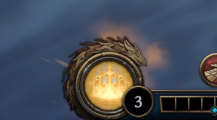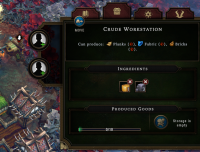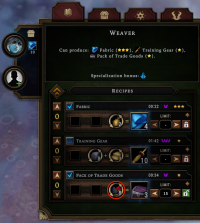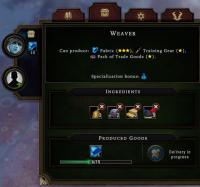|
|
| Line 126: |
Line 126: |
| Most buildings have internal storage, where (a) gathered or produced [[Resources]] are kept until a batch can be taken to the [[Warehouse]] or (b) input Resources are brought from the Warehouse for processing. The capacity of this Storage can be increased by [[Perks]] and [[Upgrades|Upgraded]] in the [[Smoldering City]]. | | Most buildings have internal storage, where (a) gathered or produced [[Resources]] are kept until a batch can be taken to the [[Warehouse]] or (b) input Resources are brought from the Warehouse for processing. The capacity of this Storage can be increased by [[Perks]] and [[Upgrades|Upgraded]] in the [[Smoldering City]]. |
|
| |
|
| In the example screenshot, a [[Woodcutters' Camp]] has an internal Storage capacity of 15. It is holding 8 [[Wood]] and 6 [[Copper Ore]] that are awaiting delivery to the closest Warehouse. The blue button to '''Force delivery now''' is dimmed because a [[Worker]] is on their way back to the Camp to deliver these goods. Pressing this button when the Storage is not full will force a Worker to take the goods to the Warehouse before it is full (and possibly before their own [[Carrying|Carrying Capacity]] would be most efficiently used). This is useful if you have Buildings awaiting construction or Glade Events that need Resources as soon as possible. | | In the example screenshot, a [[Woodcutters' Camp]] has an internal Storage capacity of 15. It is holding 8 [[Wood]] and 6 [[Copper Ore]] that are awaiting delivery to the closest Warehouse. The blue button to '''Force delivery now''' is dimmed because a [[Worker]] is on their way back to the Camp to deliver these goods. Pressing this button when the Storage is not full will force a Worker to take the goods to the Warehouse before it is full (and possibly before their own [[Carrying|Carrying Capacity]] would be most efficiently used). This is useful if you have Buildings awaiting construction or [[Glade Events]] that need Resources as soon as possible. |
|
| |
|
| ==== Ingredients Storage ==== | | ==== Ingredients Storage ==== |
Buildings are your main way of meeting the Needs of your Villagers by way of gathering, farming, production, and consumption. They occupy map tiles, constrain the movement of Villagers, and offer a variety of capabilities to help your settlement survive.
Blueprints & Construction

The Reputation icon shimmers when you can choose new Blueprints.
Buildings require you to obtain their Blueprint. You start the game with a few Blueprints, which you learn about during the Tutorial. You can choose additional Blueprints by gaining Reputation, buying from Traders, and from Glade Event rewards. A small number of Blueprints are Essential, meaning they will always be unlocked at the beginning of each settlement. You can buy upgrades in the Smoldering City to add a few more Blueprints as Essential for every map (for example, Human House, or be able to choose an Essential Blueprint when Embarking.
Builders
Buildings are constructed by Villagers that aren't assigned to work anywhere else, and they become Builders. If you need a Building built quickly, you will need to dismiss several workers from their workplaces. If no Builders are available, a hammer icon will appear above all Buildings that are awaiting construction, letting you know that you need to dismiss a worker somewhere or the construction will never finish.
Construction Toolbar

The construction toolbar at the bottom of the screen, also showing the tooltip over the second icon for Camps, which looks like a mushroom and leaf. Hold your mouse over an icon to see the tooltip.
Buildings are constructed by selecting from the options at the bottom of the screen and then clicking on the game map where you wish it to be placed. From left to write, the construction icons contain the following options:
 Roads, which are not Buildings, but improve Villagers' ability to move between them
Roads, which are not Buildings, but improve Villagers' ability to move between them Camps, and you start most maps with the same 4 options: Woodcutters' Camp, Stonecutters' Camp, Harvesters' Camp, and Scavengers' Camp before being able to choose more Blueprints
Camps, and you start most maps with the same 4 options: Woodcutters' Camp, Stonecutters' Camp, Harvesters' Camp, and Scavengers' Camp before being able to choose more Blueprints Food Production, for example for farming and cooking Recipes
Food Production, for example for farming and cooking Recipes Housing, and you start every map with at least the option for the basic Shelter
Housing, and you start every map with at least the option for the basic Shelter Industry Buildings, which produce Resources, sometimes by themselves but usually with Recipes
Industry Buildings, which produce Resources, sometimes by themselves but usually with Recipes City Buildings, which includes Hearths, Warehouses, and the Trading Post, but will also contain Buildings which provide Services when you have choose their Blueprints.
City Buildings, which includes Hearths, Warehouses, and the Trading Post, but will also contain Buildings which provide Services when you have choose their Blueprints. Decorations, which are also not Buildings, but used to upgrade Hearths
Decorations, which are also not Buildings, but used to upgrade Hearths
Next to the construction toolbar are the buttons for marking trees (the axe icons). To the far right is the button for destroying Buildings, roads, or deposits.
Range

Selecting the Ancient Hearth shows the range within which Housing must be placed to be functional.
Depending on the Building you've chosen to build (or move), the game may reveal one or more special overlay areas, highlighting, or icons:
- the range of the Hearth may be shown when placing another Hearth, Houses, or Decorations
- the range of gathering or farming when placing a Camp or Building that requires Fertile Soil
- highlighting of tiles that contain Fertile Soil when placing Farms
- icons of nearby relevant Resources when placing gathering Camps and Mines
- highlighting of Trees that have been marked for cutting in a different color when in range of the Woodcutters' Camp
Most Industry Buildings typically do not need to show any of these things. (The Mine is an exception). For example, when placing a Provisioner, there are no overlays or icons shown.
Building Panel

The Building panel for a Weaver.
The Building panel contains information on a Building you have selected or placed for construction on the map. Counter-clockwise starting at the top of the panel, you can see four tabs, the Workers, and the content of the tabs. The center-top of the panel, below the tabs, will show the Building's description, which typically includes a summary of its Recipes and any Specialization.
Moving a Building

This Camp is a moveable Building.

If a Building may be moved, the button to do so appears large, in blue, at the top left the Building panel. Holding your mouse over the button will tell you whether the Building may be moved for free, like a Camp. Some Buildings can be moved for a cost, like a Shelter for 5 Wood. Most Buildings that produce goods using Recipes cannot be moved at all, and the icon will not appear on their Building panel.
You can see before constructing a Building whether it will be moveable. This appears on the same tooltip where you can preview the cost of the Building before placing it for construction. In the screenshot to the right, notice the blue Move button on the Building's picture in its construction tooltip.
Workers

Example building panel showing 3 Workers with 3 different statuses.
Most Buildings have space for two or more Villager to work. Selecting a Building open its panel on the right side of your game window. There, you can assign or dismiss Villagers as Workers.
Next to the Worker icon, like a Human, a small icon will appear that indicates the status of the Worker. They may be the following:
 = walking to the Building
= walking to the Building = actively producing or gathering
= actively producing or gathering = moving goods from the Building to a Warehouse or vice versa
= moving goods from the Building to a Warehouse or vice versa = resting at the Hearth
= resting at the Hearth = idling, unable to work
= idling, unable to work
If the worker is unable to work, then their icon will be an exclamation point. This occurs when there are no more Resources to work with (whether from the nearby map tiles or from the Warehouse) or if you must select one of the options of a Glade Event and press the Investigate button. The Building will also receive an exclamation point icon above it on the map view (even with the Building panel closed) to get your attention since an idling Worker may be wasting valuable time, however you are free to ignore these icons.
Empty Worker Slots

If a Building has space for more Workers, you click the black-and-white icon with a nondescript person and green plus sign to choose which Species to add.
There are noteworthy reasons to leave Worker slots empty in Buildings. For example, emptying the Woodcutters' Camps of all of their Workers just before the Storm can lower the Hostility of the Forest enough so you don't lose any Villagers during the Storm due to low Resolve. Another example is if your settlement is producing a good more quickly than it is needed, removing a Worker will slow down the rate of production.
Specializations
Some Buildings will indicate that there are Specializations available with small, color-coded icons. You can hold your mouse over these icons to see a tooltip that identifies the name of the Specialization. However, the name does not tell you which of the two types of Specializations it is. Specializations either grant bonus to Resolve or chance for double production. A Building like the Cookhouse with 4 Worker slots can be used to boost the Resolve of the Lizards by assigning four Lizards to it due to its Warmth Specialization.
First Tab: Recipes
See also: Recipes

On the Building Panel for production Buildings, the first tab contains the Recipes that the Building can produce. For Buildings like Camps and Farms, there are no tabs and the Recipes and internal Storage are shown together.
In the list of Recipes, you can check or uncheck the Recipes you want the Workers to produce. By default, all Recipes are enabled. You may want to uncheck to disable Recipes that are lower efficiency than in other Buildings. For example, you may want to disable the Recipe for Planks in the Crude Workstation ({{0star]]) once you have built a Lumber Mill (Template:3star), so you get the most efficient use of Wood. However, if your are in need of more Planks and you can afford to spend the extra Wood, it may be worth it to keep the Planks Recipe checked in the Crude Workstation.
In the list of Recipes, you can also click the up and down arrows to increase or decrease the priority of a Recipe. This will reorder the list, so the highest priority Recipes are on top. When a Recipe is prioritized in a Building, the Workers will spend all of their time making that Recipe. Once they are unable to produce more, they will move on to the next-lower priority Recipe. This may happen when the settlement runs out of the ingredient Resources or the Limit is reached.
On the right side of the Recipes list, you can set the Limit of the Recipe. When the settlement has that number of that product Resource in the Warehouse, then the Workers will not start producing more. Sometimes the deliveries to the Warehouse have not been made yet, so Workers may start another batch, and the Limit may be exceeded, so consider this as a soft target not a rigid constraint.
Second Tab: Storage
See also: Storage and Warehouse

Produced Goods Storage

The internal Storage in a Woodcutters' Camp is almost full. It has 8 Wood and 6 Copper Ore that need to be delivered to a Warehouse.
Most buildings have internal storage, where (a) gathered or produced Resources are kept until a batch can be taken to the Warehouse or (b) input Resources are brought from the Warehouse for processing. The capacity of this Storage can be increased by Perks and Upgraded in the Smoldering City.
In the example screenshot, a Woodcutters' Camp has an internal Storage capacity of 15. It is holding 8 Wood and 6 Copper Ore that are awaiting delivery to the closest Warehouse. The blue button to Force delivery now is dimmed because a Worker is on their way back to the Camp to deliver these goods. Pressing this button when the Storage is not full will force a Worker to take the goods to the Warehouse before it is full (and possibly before their own Carrying Capacity would be most efficiently used). This is useful if you have Buildings awaiting construction or Glade Events that need Resources as soon as possible.
Ingredients Storage

The ingredients Storage in an empty Crude Workstation are inaccessible to other Buildings that could use them.
In another example, a Crude Workstation has been replaced with Buildings with more efficient (higher-star) Recipes. Clicking the red X icon on the Resource's icons instantly transfers these Resources back to the Warehouse. If you accidentally remove the wrong ingredient, a Worker will need to go pick the ingredients back up from the Warehouse before they can work on the Recipe.
List of Buildings
Main page: List of Buildings
Starting Buildings
Every settlement starts with an Ancient Hearth and Main Warehouse.
Buildings every settlement starts with
| Building |
Purpose |
Workplaces |
Specialization
|
 Ancient Hearth Ancient Hearth
|
Heats nearby Houses. Villagers gather here to rest and eat.
|
1
|
 Warmth Warmth
|
 Main Warehouse Main Warehouse
|
Centralizes resources for settlement supply chain.
|
3
|
none
|
Camps
Camps are starting points for your settlement to go out into the wild to gather Resources from the map in a small area around them. Selecting a Camp from the construction menu will highlight their range and show icons for the resource deposits or trees from which the Camp can gather. All Camps can be moved for free.
Some of the Camps have smaller and larger versions. If the Camp you have when you start a map is named "Small," then you can upgrade it by unlocking the Blueprint for the larger version. Small camps can only gather from small resource nodes; the regular camps
Food Production
Food production Buildings include Farms and Buildings whose primary purpose is Recipes for food. Many of these buildings also produce non-food items from farming or include non-food Recipes. This may give you more options or less in choosing your Blueprints, depending on how strict your needs are.
Housing
Housing Buildings must be constructed within range of a Hearth to work. These buildings satisfy villagers' need for shelter. Certain Housing Building also satisfy villagers' need for their species-specific housing. These have fewer places for residents and require that you unlock their Blueprints.
Industry Buildings
Industry Buildings produce intermediate crafting and building materials, trade goods, and the finished goods used for Services and other effects. Most of these buildings require you to unlock their Blueprints before you can place them. The four that you start with are listed first in the table.
City Buildings
City Buildings include buildings that provide Services and passive effects and the buildings that everyone starts out being able to access that provide essential settlement functions of Hearths, Warehouses, and Trade. Services Buildings can be quite expensive to build, costing upwards of several dozen building materials. The Blight Post and Forsaken Altar become available at different Difficulty levels: Veteran and Prestige 1, respectively.
Services Buildings
City Buildings
Blights Posts and Hydrants can only be constructed if the game difficulty is at least Veteran.
| Building |
Cost |
Effects
|
 Small Hearth Small Hearth |
 5 Bricks 5 Bricks
 5 Planks 5 Planks
 1 Wildfire Essence 1 Wildfire Essence |
Same effects as the Ancient Hearth. Can't be constructed close to other Hearths.
|
 Storage Storage |
 2 Bricks 2 Bricks
 2 Plant Fiber 2 Plant Fiber
 1 Parts 1 Parts |
Stores a large amount of goods and protects them from the rain. Workers always deliver and take goods from the Storage nearest to them.
|
 Trading Post Trading Post |
 10 Wood 10 Wood |
Traders from the Smoldering City can station here and offer their wares.
|
 Tavern Tavern |
 20 Planks 20 Planks
 8 Fabric 8 Fabric
 4 Bricks 4 Bricks |
Satisfies Leisure, Brawling. Gives the Gleeman's Tales perk.
|
 Blight Post Blight Post |
 3 Bricks 3 Bricks
 4 Planks 4 Planks
 2 Parts 2 Parts |
Produces and uses Purging Fire.
|
 Hydrant Hydrant |
 1 Bricks 1 Bricks
 3 Planks 3 Planks |
Stores Purging Fire.
|
Decorations
Decorations are used to advance hubs. All decorations take 10 seconds to be constructed.
| Decoration |
Bonus |
Cost
|
 Bench Bench |
Comfort |
 2 Wood 2 Wood
|
 Barrels Barrels
|
 Fence Fence
|
 Fence Corner Fence Corner
|
 Bush Bush |
Aesthetics |
 1 Planks 1 Planks
|
 Flower Bed Flower Bed
|
 Fire Shrine Fire Shrine |
Harmony |
 1 Planks 1 Planks
 1 Fabric 1 Fabric
 1 Bricks 1 Bricks
|
 Lizard Post Lizard Post
|
 Roads, which are not Buildings, but improve Villagers' ability to move between them
Roads, which are not Buildings, but improve Villagers' ability to move between them Camps, and you start most maps with the same 4 options: Woodcutters' Camp, Stonecutters' Camp, Harvesters' Camp, and Scavengers' Camp before being able to choose more Blueprints
Camps, and you start most maps with the same 4 options: Woodcutters' Camp, Stonecutters' Camp, Harvesters' Camp, and Scavengers' Camp before being able to choose more Blueprints Food Production, for example for farming and cooking Recipes
Food Production, for example for farming and cooking Recipes Housing, and you start every map with at least the option for the basic Shelter
Housing, and you start every map with at least the option for the basic Shelter Industry Buildings, which produce Resources, sometimes by themselves but usually with Recipes
Industry Buildings, which produce Resources, sometimes by themselves but usually with Recipes City Buildings, which includes Hearths, Warehouses, and the Trading Post, but will also contain Buildings which provide Services when you have choose their Blueprints.
City Buildings, which includes Hearths, Warehouses, and the Trading Post, but will also contain Buildings which provide Services when you have choose their Blueprints. Decorations, which are also not Buildings, but used to upgrade Hearths
Decorations, which are also not Buildings, but used to upgrade Hearths = walking to the Building
= walking to the Building = actively producing or gathering
= actively producing or gathering = moving goods from the Building to a Warehouse or vice versa
= moving goods from the Building to a Warehouse or vice versa = resting at the Hearth
= resting at the Hearth = idling, unable to work
= idling, unable to work
 Hooded Horse Wikis
Hooded Horse Wikis


























